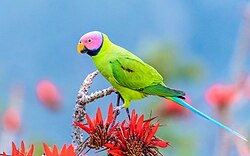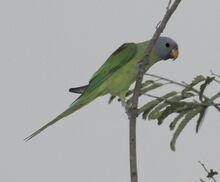Biology:Blossom-headed parakeet
| Blossom-headed parakeet | |
|---|---|

| |
| Scientific classification | |
| Domain: | Eukaryota |
| Kingdom: | Animalia |
| Phylum: | Chordata |
| Class: | Aves |
| Order: | Psittaciformes |
| Family: | Psittaculidae |
| Genus: | Psittacula |
| Species: | P. roseata
|
| Binomial name | |
| Psittacula roseata Biswas, 1951
| |
| Synonyms | |
| |
The blossom-headed parakeet (Psittacula roseata) is a parrot in the family Psittaculidae.
Taxonomy
Two subspecies are recognised:[1]
- P. r. roseata Biswas, 1951 – West Bengal (India) to Bangladesh
- P. r. juneae Biswas, 1951 – northeast India and north Myanmar to Indochina
Description
Himalayapsitta roseata is a lime-green parrot,[2] 30 cm (12 in) long with a tail up to 18 cm (7.1 in). The male's head is pink becoming pale blue on the back of the crown, nape and cheeks. There is a narrow black neck collar and a black chin stripe. There is a red shoulder patch and the rump and tail are bluish-green, the latter tipped yellow. The upper mandible is yellow, and the lower mandible is dark. The female has a pale grey head and lacks the black neck collar[2] and chin stripe patch. The lower mandible is pale. Immature birds have a green head and a grey chin. Both mandibles are yellowish and there is no red shoulder patch.[3] The different head colour and the yellow tip to the tail distinguish this species from the similar plum-headed parakeet (H. cyanocephala).
Distribution and habitat
This species is a resident breeder in Eastern Bangladesh, Bhutan, Northeast India and Nepal, eastwards into South-east Asia (Cambodia, Laos, Myanmar, Thailand and Viet Nam) and also China .[4] Blossom-headed parakeet inhabits lowland and foothill open forests and forest edges. [2]
Behaviour and ecology
Blossom-headed parakeet nests in holes in trees, laying 4-5 white eggs. It undergoes local movements, driven mainly by the availability of the fruit and blossoms which make up its diet. It is a gregarious and noisy species with range of raucous calls. [5]
Bibliography
- Grimmett, Inskipp y Inskipp, Birds of India ISBN 0-691-04910-6
- Josep del Hoyo, Andrew Elliott, Jordi Sargatal (Hrsg.): Handbook of the Birds of the World. Volume 4: Sandgrouse to Cuckoos. Lynx Edicions, Barcelona, 1997. ISBN 8487334229
- Joseph Michael Forshaw: Parrots of the World - An Identification Guide. Princeton University Press, Princeton 2006, ISBN 978-0-691-09251-5.
External links
- Ouseaux (in French)
- Tutto pappagalli (in Italian)
References
- Birds of India by Grimmett, Inskipp and Inskipp, ISBN:0-691-04910-6
| Wikimedia Commons has media related to Blossom-headed parakeet. |
- ↑ Gill, Frank; Donsker, David; Rasmussen, Pamela, eds (July 2023). "Parrots, cockatoos". IOC World Bird List Version 13.2. International Ornithologists' Union. https://www.worldbirdnames.org/bow/parrots/.
- ↑ 2.0 2.1 2.2 ebird
- ↑ Word Parrot Trust
- ↑ Cite error: Invalid
<ref>tag; no text was provided for refs namediucn - ↑ xeno-canto
Wikidata ☰ Q110279167 entry
 |




